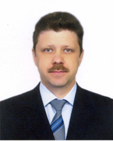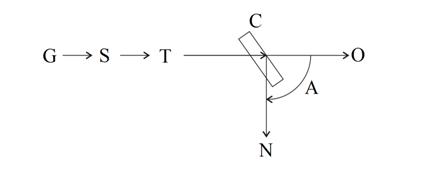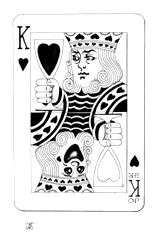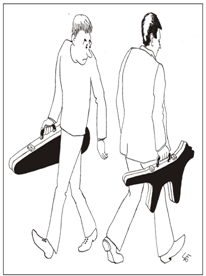Inside TRIZ
 Development of the Creativity and Formula of the
Development of the Creativity and Formula of the
Nontechnical Systems' Transformation Algorithm
by Eugene Chikov and Nikita Chikov
The article considers potential of caricature in the development of the creative thinking and reveals the structural model of the caricature creating process; it compares logical operations while solving inventive problems in techniques (Su-Field analysis) and while getting the new result within the context of the nontechnical system. This article also offers the formula of the nontechnical systems' transformation algorithm (solving of the nontechnical creative problem), which is common for all nontechnical systems.
Key words: Su-field analysis, nontechnical systems' transformation algorithm, creative thinking development
"The potential of trial-and-error approach is exhausted... That is why creation of the algorithms for solving technical, scientific and other tasks is not only possible, but also necessary. ARIZ will be followed by algorithms for solving the scientific and other tasks. The development of General Theory of Creative Problem Solving will inevitably be started some day. But now we are at the very beginning of our way."
G. Altshuller, A. Selutzkiy "Wings for Ikarus"
Nowadays correlation between economical and technological development of the society and intellectual component of the human labour is increasing. Obvious fact that creative (constructive) resources of the man are endless and material resources are limited, influences the nature of production of material goods as well as spiritual (intellectual) economic products. In the first place, they are considered as a result of using the creative resources of the human. It is implied, that somebody will find original solution, unnoticed before, by connecting parts of objective environment in unusual way. In other words, he will use creativity to solve the problem, if we understand creativity as the ability to think originally, develop unexpected new decisions, bring new experience into work.
While developing creative thinking, special attention should be given to the psychological emancipation, deliverance from stereotypes. It is caricature, that implements such psychological method as "everything is possible!". This method takes of all the limits while depicting the objects: in style, plot, genre, level of artist's skills. Themostimportantthingisthemanifestationofthought!
Caricature is initially aimed at showing some phenomenon in a funny, ridiculous way by intentional distortion of the presented material. Comical effect is reached by marked breach of ordinary proportions. That is, when we begin our work in this genre, we have a criterion of its productivity: if it funny, we have a positive outcome, and we get an important mental attitude, that it is necessary to distort usual things to make it unusual.
Irony in the caricature is also important. It means that a viewer, looking at the picture, gets completely unexpected original result which doesn't coincide with the initial supposition about further unraveling of the plot. This contradiction often appears as a result of outwardly habitual logics of the discourse, but the conclusion does not follow from initial premise, and also contradicts it, providing sudden and original interpretation, that intensifies comical effect.
While drawing a caricature, we may ignore most of the conventions and stereotypes without losing out connection with real life. Popularity and accessibility of this genre among all levels of population makes it easily understandable without additional comments.
Having analyzed the logics of creating caricature, we can try to show the laws of finding a creative solution in general. That is why we can treat caricature as the striking example of solving the problem of getting the new, creative result within the context of nontechnical system. If we find out an algorithm of structuring of the creative process, it will be possible to spread this experience on such areas of creative activity as design, literature, scientific experiment, as the powerful didactic method.
Example of the solving problem in that way is the Theory of Inventive Problem Solving (TRIZ) by G. Altshuller, and its part, devoted to the substance-field analysis. Su-field ("substance" + "field") is a system, which consists of two substances and a field.
Su-field is a model of a technical system. It is conventional and indicates just one (but the most important) characteristic of the system. Su-fieldcanbeeasilyimaginedasapicture. Field is marked as F, substances as S1 (product) and S2 (instrument, part of instrument, which interacts with the product); direction of field and substances movement is shown by arrows. Su-field "language" allows us to write down what we have (i.e. task model) and what we get after solving.
For example,

Wavy arrow symbolizes unsatisfactory interaction. Double arrow replaces the words "to solve the problem pass to ...". Su-field formulas allow us to transform technical systems, using their structural models.
If we deal with nontechnical systems, Su-field formulas, which we use to fix transformations, will be another. This happens, because all the fields and substances can remain unchanged. Our attitude about the situation changes as we change our point of view on it or its components.
The first very important task is precise defining and pointing out the point of view at the system and the situation in general. This completely new proposition should be kept in mind when we are developing the way of fixing the solution and algorithmization of the creative scopes of activity.
The second important distinction is an absence of a single beauty, harmony and creative efficiency scale. White colour is a symbol of joyful events for the Western people, but for the people of the East it symbolizes mourning.
And the third distinction is that we shouldn't expect only one result. We should be ready to face a great number of solutions and choose acceptable from them (it doesn't have to be an ideal one!). Although when we speak about engineering, everybody will usually be satisfied only with IER - Ideal End Result, which is obvious, provable and doesn't have another options.
Taking into account all these features, algorithm for creating a caricature can be shown as following:

where G – general, usual idea about something;
S – stylization;
T – transformation;
C – «semi-transparent mirror», context;
N – new quality of object (unexpected result);
O – objective, expected result of transformation;
A– displacement angle between the expected (O) and unexpected (N) result;
→ – directionofinteraction.
General, usual idea about something (G) is initial situation, system before transformation.
Under stylization (S) we should understand the features of the object's depicting. They can be the peculiarity of the artist's style, shown either unconsciously or intentionally in case to assign some special meaning to the picture. Sometimes only stylization is enough to make the object funny. To this part we can also include already existing, successful methods - a kind of "database", like a patent stock in engineering.
Transformation (T) can result in adding some qualities to the object (humanizing, innocence, strictness, personification of a fairytale or aphorism etc.); similarity coefficient (external similarity, course of action); unnecessary rationalization or "abstruse transformation" (mechanization, simplification, creation of home comforts, spheres of activity, setting in narrow bounds in advance); course of time (slower or faster); castigation.
"Semi-transparent mirror" or context (C) is a part which allows us watch and assess simultaneously the following: the system before transformation, objective of the transformation and new quality of the system, which we get after transformation. "Semi-transparent mirror" creates the context of the future transformation, stylization, and tinges the transformation with a new meaning like a colour filter. Crossing of the two directions (→) on the semi-transparent mirror's surface gives us the point of view, which influences our assessment of the whole process.
New quality of the object (N), acquired (seen) as a result of the transformation or stylization is often an unexpected result, which was unnoticed or considered unimportant. This is one of the possible results in the area of solutions for the given problem. Semi-transparent mirror allows us to watch the objective (O) and our deviation from the initial direction at the same time.
Objective (O) is an expected result of the given system's transformation according to the existing stereotypes, in case of the absence of the transformation.
Displacement angle (A) between objective (O) and new quality of the object (N)
limits the admissibility, quality and number of system's transformations.
In most cases the displacement angle makes the result funny. Surprised spectator discovers that his viewpoint on the object isn't the only one and it differs from the stereotype (his previous viewpoint). The more this angle - the more precise and wittier the artist managed to discover the hidden essence, which was inaccessible for the spectator before, and the funnier is the caricature in general.
We work with this scheme in the direction, shown by the arrows (→).

For example, we are going to draw a caricature of an alcohol abusing man. Thisisacontext (M). Objective (O) is a man, a picture of him. Spectators expect to see a man first of all. All the disgusting things about alcoholism are not evident (N). That is why the main task of the artist is to underline negative points, which characterize inebriated style of life (T). Discrepancy of the expected and seen gives us the displacement angle (A), which makes us laugh. (Fig. 1)
Fig.1, E. Chikov. "My lord, drinking harms you!"
Another example of the caricature is using extra rationalizing as transformation (T) (Fig. 2) Niche specialization of the case itself elicits a smile.This formula can be successfully used for work within the context of the other nontechnical systems. Meaning of the elements may vary, but algorithm will be unchanged.

Maybe, later an orderly science, like Mendeleev's periodic table, will be created. But now we
rely on our own artistic taste of different level, not on the scientific recommendations. We should also mention, that "Columbus effect" - "swam to India, came to America" - is especially strong, if we deal with nontechnical systems. Very unusual and interesting solutions appear as a result of it.
Fig. 2.,E. Chikov.«To the circus & to the rehearsal»
About the authors:
Eugene Y. Chikov - senior lecturer of South Russian State Technical University who teaches industrial design and ergonomics. Also he is a professional artist and designer, prize-winner of state and regional contests. He has authored many scientific articles, published in Russian scientific magazines.

Nikita E. Chikov - lecturer and postgraduate student in pedagogies in Tula State Leo Tolstoy Pedagogical University, Russia. Now is working at the thesis, devoted to the development of the teacher's creativity. He has authored numerous scientific articles, published in Russian scientific magazines, including the recommended by the State Commission for Academic Degrees and Titles.
Contacts: E-mail: This email address is being protected from spambots. You need JavaScript enabled to view it.
Cell:+79534233882
Address: Gagarina Street 16-7, Leninskiy District, Tula region 301131
Russian Federation
